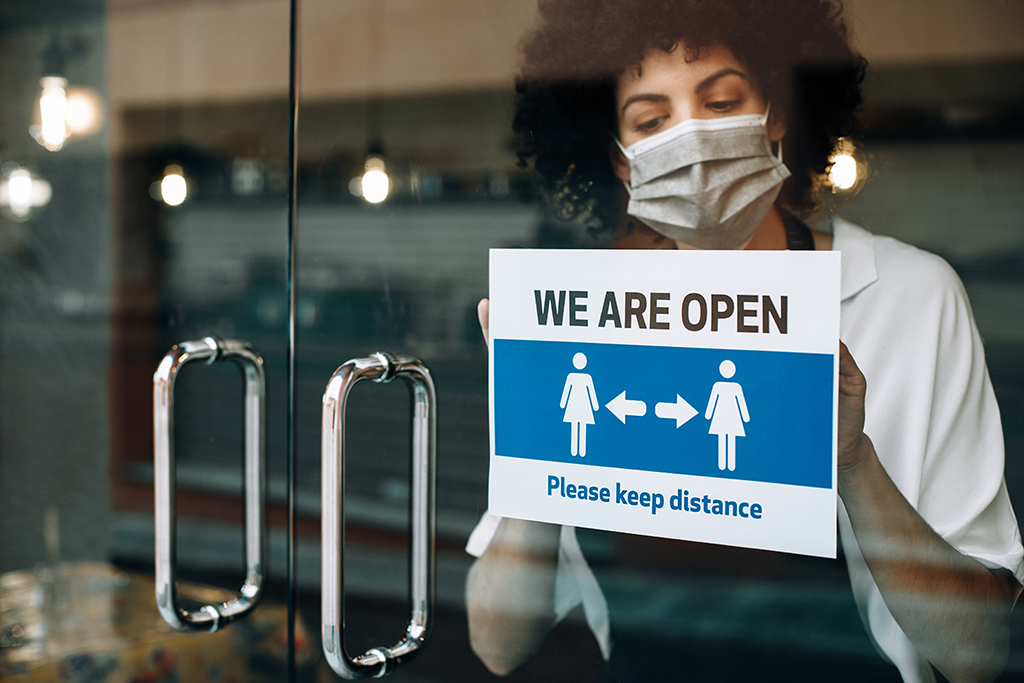As of October 2020, over seven million people in the United States have contracted COVID-19, and more than 16 million continue to face unemployment. As the dual health and economic crises continue to unfold, communities that understand which residents are at higher risk of job-related virus exposure and which are at higher risk of financial instability can more effectively direct resources to support their constituents.
A Tool for Understanding the Workers and Communities at Risk in the COVID-19 Crisis
To help shed light on these issues, TIP Strategies examined characteristics of occupations across the US and assigned each a health risk score and a risk to earnings score. These scores form the basis for the Occupational Risk Tool. Using the two risk scores, each occupation is placed on a plot that reflects the job-related personal health risk and risk to earnings workers in that occupation face relative to others. To better illustrate which regions may be more vulnerable, the tool also includes a map of metropolitan areas that shows the share of workers in each risk category by metro. Other features include a table comparing worker demographics by their risk; a risk breakdown of major occupations and industry sectors; and interactive filters to dive into specific regions, occupations, and occupational characteristics. [Continue scrolling to read the lessons we’ve learned after the interactive tool below.]
WHAT CAN WE LEARN FROM THE OCCUPATIONAL RISK TOOL
1. Workers in jobs with high risks to earning and to personal health represent 40% of the US workforce.
Over 66 million workers in the US are employed in jobs with both high risks to earnings and high risks to personal health. This number represents 40 percent of all workers in the US. Some of the largest occupations in the highest risk quadrant include waiters and waitresses, cashiers, janitors and cleaners, and food preparation workers. Similar analyses have found that workers in essential jobs face the greatest risk of contracting the virus, and many workers in the service industry have been affected by the COVID-19 recession. It is important to note that many healthcare workers are not categorized in the highest risk category. While they have the highest risk of contracting the virus, healthcare workers face less risk of losing their jobs or incomes, because their jobs are deemed essential during the pandemic. The scale of risk evident in the US workforce indicates that significant protections for workers’ health and finances will be necessary for keeping businesses open and supporting economic recovery.
2. Risks faced by nearly 14 million food workers will have ripple effects throughout the economy.
More than 13.7 million Americans work in food preparation and serving related occupations. Among these workers, which include waiters and waitresses, bartenders, and various types of cooks, all but private chefs have high risk to earnings and moderate-to-high personal health risk. Moreover, most of these jobs are not salaried and have a median hourly wage under $20—even a temporary period without work or income could have major financial impacts for these workers and their families. This earnings risk has been a major contributor to national unemployment levels. According to the US Bureau of Labor Statistics, service occupations (a broader group that includes food preparation workers, groundskeepers, and other personal service workers) had an 18.8 percent unemployment rate in June 2020, well above the 11.1 percent national unemployment rate. As a result, regions with high proportions of food service workers—typically a sign of a large tourism industry—have also seen some of the highest regional unemployment. Major tourism centers, such as the Atlantic City metro (34 percent unemployment) and the Las Vegas metro (18 percent) have been especially hard it.
3. Black, Latinx, and younger workers face a disproportionate level of risk.
Numerous articles have been written about the disproportionate risk that workers of color, especially Black and Latinx workers, have faced during the COVID-19 pandemic. A CNN piece called “The Color of Covid” indicates that Black and Latinx workers are overrepresented among essential and unemployed workers. From an economic standpoint, Black and Latinx workers are providing essential services and are less able to work remotely during this period. While Black and Latinx people comprise 28.3 percent of the US population, they represent 32.8 percent of workers in the highest risk quadrant. Young workers under the age of 25 are also disproportionately at risk, as many work in essential jobs or jobs that have been eliminated during the pandemic. Though the virus may be colorblind, the systems and structures in which we live are not. Business and government leaders must recognize the need to provide equitable and targeted support to Black and Latinx workers who bear the greatest burden during the pandemic.
4. Of workers facing the greatest risk, 83 percent earn less than $20 per hour.
Workers earning below $20 per hour represent 83 percent of all workers in the highest risk quadrant. Even pre-pandemic, these jobs do not pay living wages. Many workers in low-wage occupations entered the pandemic in tenuous financial positions. Now, those same workers are either unemployed or even more dependent on jobs that expose them to a higher number of risks. It is important to recognize that many of these low-wage jobs are held by Black and Latinx workers, who are already disproportionately impacted by the health and economic consequences of the pandemic. In response, national organizations have strengthened their call for increased worker protections to grant greater financial security to those at risk. Concerns about economic security were evident in Federal Reserve Chairman Jerome Powell’s October 6, 2020, address to the National Association for Business Economics, which noted that, “[t]oo little support would lead to a weak recovery, creating unnecessary hardship for households and businesses.” States and local communities also need to play a stronger role in supporting these workers through economic recovery and beyond to economic prosperity.
5. Regions with less resilient industries may face more severe crises.
The share of workers in high-risk and low-risk occupations varies by metropolitan area depending, in part, on regional specialization in different industries. For instance, more than 57 percent of the 10.9 million workers in the professional services sector fall into the low risk to earnings and health quadrant, compared to only 5.3 percent of the 16.3 million workers in retail industries. Because of this relationship between occupational risk and industry, regions with larger low-risk sectors may be positioned to weather the crisis better than metros where high-risk sectors dominate the job base. Moreover, specialization is a long-term economic characteristic. Regions with a strong professional sector, robust manufacturing center, or heavy reliance on tourism take years of direct and indirect efforts to develop. As a result, regional industry specializations may exacerbate pre-existing inequalities between metros as the crisis inflicts higher economic and health tolls in regions with less resilient industries.
Building a More Equitable and Resilient Economy for Workers
The last several months brought about momentous change—a health pandemic, an economic crisis, and a broader awakening to ongoing racial and social injustice. While COVID-19 has been unprecedented in some ways, the pandemic has also exposed and exacerbated existing fault lines in our economy and communities. The data and takeaways in TIP’s Occupational Risk Tool are not surprising, but they can be instructive.
Millions of workers in the US face significant health and economic risk every day, and this risk is not distributed evenly, either across the country or within our local communities. Black and Latinx workers have disproportionately borne the brunt of risk in our economy. Our risk analysis underscores this reality, which has persisted for generations. Acknowledging existing inequities is a first step toward understanding how we can move forward in building a safer and more equitable system.
When thinking about how to use the information gathered from the risk tool, it is important to note some of the tool’s limitations. The risk tool captures data on workers that are part of the labor pool; it excludes those who are chronically unemployed or disconnected entirely. Those in the informal economy are also not captured in our tool.
The most vulnerable workers in our economy face systemic barriers that must be addressed by our political and business leaders. Given continued uncertainty about the pandemic, regional and local communities should use this economic downturn as a chance to reimagine our economic systems and workforce structures so that they work better for everyone. While there are critical and urgent needs to be addressed, it is also necessary to be strategic and think creatively. As evidenced in the data, our “normal” economic conditions failed millions of people. Now is the time to create a “new normal” that is more equitable, inclusive, and resilient.
For more information about how the Occupational Risk Tool might be used to better understand your community, contact TIP Strategies at contact@tipstrategies.com.



